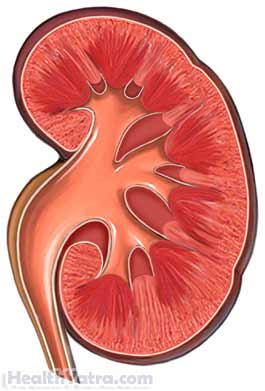সংজ্ঞা
Polycystic kidney disease (PKD) is an inherited disease that causes many cysts to form in the kidneys. The word polycystic means many cysts.
Cysts, which are sacs filled with fluid, grow in both kidneys causing them to become enlarged. The number of cysts can range from a few to a great number. The size of the cysts can vary from too small to detect, to cysts that are larger than the kidney itself.
PKD can be painful and interfere with the normal functioning of the kidney. It can result in infection, kidney stones, high blood pressure, and, eventually, kidney failure. PKD is a potentially serious condition that requires care from your doctor.

কারণসমূহ
PKD is caused by an inherited gene. It is one of the most common genetic diseases in the United States. Children have a 50% chance of developing PKD if one parent carries the gene. If a person has the PKD gene, he or she will have some form of the disease in his or her lifetime. The disease can cause different symptoms within members of the same family.
There is also a rare form of PKD, called autosomal recessive polycystic kidney disease, that affects newborns, infants, and children. This form of PKD can cause death in the first month of life.
ঝুঁকির কারণ
The primary risk factor for PKD is having a parent with the disease. Fifty percent of children born to a parent with the PKD gene develop the disease. In about 10% of cases, the gene for the disease was not inherited, but mutated. PKD affects men and women equally.
লক্ষণ
During the early stages of PKD, there are often no symptoms. Some people are never diagnosed because their symptoms are mild. Most symptoms appear in middle age.
Frequently, the first symptom is pain in the back or side. Other signs of PKD include:
- উচ্চ্ রক্তচাপ
- প্রস্রাবে রক্ত
- মূত্রনালীর সংক্রমণ
- কিডনিতে পাথর
- Additional, less common symptoms may include:
- Nail abnormalities
- Painful menstrual periods
- সংযোগে ব্যথা
- তন্দ্রা
If you experience any of these symptoms, do not assume it is due to PKD. These symptoms may be caused by other, less serious health conditions. If you experience any of them, see your physician.
রোগ নির্ণয়
Your doctor will ask about your symptoms and medical history. A physical exam will be done. When diagnosing PKD, your doctor may begin by looking for signs of the disease. These signs include high blood pressure, enlarged or tender kidneys, enlarged liver, and protein or blood in the urine.
An abdominal ultrasound is usually the first test used to detect cysts on the kidneys. If cysts are too small to be detected by ultrasound and the diagnosis is still not certain, an abdominal CT scan or MRI scan may be performed.
If the diagnosis is not confirmed, additional tests may be ordered, including:
- Gene linkage study—a blood test that tests the DNA of the patient and family members with and without PKD
- Direct DNA sequencing—blood sample of patient’s DNA to look for presence of the PKD gene
Ten to forty percent of patients with PKD also have an aneurysm (weakness in the wall of a blood vessel) in the brain. If you are diagnosed with PKD and there is a family history of a brain aneurysm, your doctor may recommend an arteriogram to detect the presence of an aneurysm.
চিকিৎসা
Most treatments for PKD treat the disease symptoms or prevent complications. Some of these treatment options may include:
- High blood pressure medicine—Since high blood pressure is common with PKD, medicines are often prescribed to control blood pressure.
- Pain medicine—Pain medicines must be used cautiously, since some of them can cause damage to the kidneys.
- Antibiotics—In the event of a urinary tract infection, aggressive treatment with antibiotics is needed to avoid damage to the kidneys.
- Surgery—Cysts may be drained through surgery to relieve pain, blockage, infection, or bleeding. Cyst drainage may also temporarily lower blood pressure. Sometimes, one or both kidneys may be removed if pain is severe. This procedure is called nephrectomy.
- Diet—A low-protein diet may reduce stress on the kidney. Avoiding salt can help keep normal blood pressure and drinking lots of water can help reduce the risk ofkidney stones.
- Dialysis and transplantation—More than half of PKD patients develop kidney failure and need dialysis. Dialysis is used to remove wastes from the blood, since the kidneys cannot. At this stage, dialysis will be a lifelong requirement unless a kidney transplant from a donor can be done successfully.
Recent research has led to the creation of several drugs that may prevent cysts from developing. An example is somatostatin, which has been studied in humans and may one day be available to prevent polycystic kidneys from developing.
প্রতিরোধ
PKD is an inherited disease and is not preventable. If you have a family history of PKD, you may want to talk to your doctor about genetic testing.
